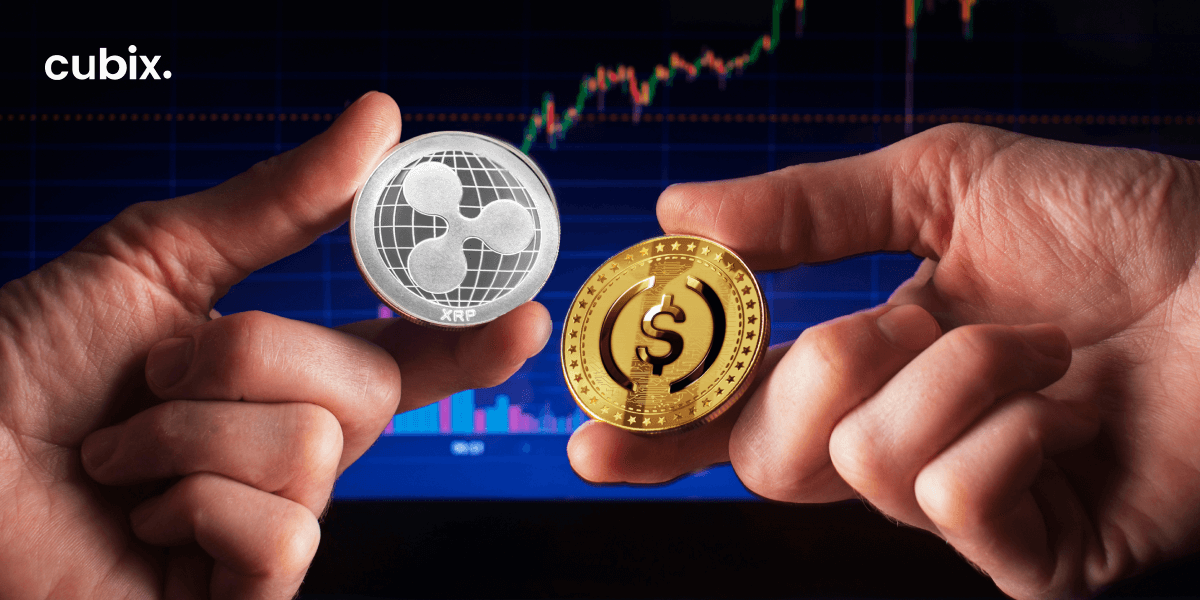Digital transformation is being embraced rapidly, and recent technological introductions that accompany this adoption appear to diversify quite swiftly. The nature of potent technologies is such that once people see their possibilities, investing in them almost becomes a routine matter.
Digital currencies and their alternatives are prime examples of this. They allow way more flexibility compared to traditional currencies in terms of traceability and fluidity, which are governed by blockchain technology. It is this immutable, decentralized ledger (the blockchain) that we might rightly refer to as the backbone of not just cryptocurrencies, but many other utilities.
Following the cryptocurrency boom, attention gradually turned toward its proverbially diverse offspring. altcoins and stablecoins have stemmed from prominent cryptocurrencies. However, there is a distinction; Bitcoin and Ethereum stand alone, but Altcoins and Stablecoins encompass all other cryptocurrencies.
While that’s quite widely known, let’s unearth the key differences when we compare altcoins vs stablecoins.
What is Altcoin?
As we already know, altcoins or alternative coins encompass cryptocurrencies, excluding Ethereum (ETH) and Bitcoin. Developers with a unique perspective design altcoins with features that are more distinctive than the other ordinary types of crypto coins.
Their architecture is based on a peer-to-peer network, and the process solves complex problems and carries out web transactions inexpensively. Although they are susceptible to attacks to some extent, penetration is more easily detected.
Although altcoins come in many forms, here are a few examples.
Types of Altcoins
Mining-based
These are classified into two categories, proof-of-work altcoins, and pre-mined altcoins.
Proof-of-work altcoins are created by solving mathematical queries. Major examples are Litecoin and Zcash.
Pre-mined altcoins are the opposite. These do not involve any mathematical query. Ripple’s XRP is an example.
Governance
With governance tokens, as a user, you have rights to a decentralized autonomous organization (DAO), allowing you to vote on proposals based on cryptocurrency. This permits decision-making and does not allow a superior command to a central authority.
Memecoins
This is a type of altcoin receiving tremendous public attention, perhaps through social media or the tweets of celebrities such as Elon Musk. Memecoins often have a humorous aspect to them, such as Dogecoin and Shiba Inu. Their prices rise and fall spontaneously.
Security Tokens
This type of token allows more security assets to be scrutinized. Take the example of a piece of art that first divides ownership and then validates it, or a company that can represent its ownership by security tokens.
Staking-based
Holders of the staking-based cryptocurrency are allowed to stake their coins, and they can be used in the future for transaction processing. The process includes selecting a participant to verify the blocks of transactions, and in return, the participant gets compensated.
Read More: NFT Game Development Checklist: A Complete Guide
Examples of Altcoins
USD Coin
Launched in September 2018, USD Coin owns stablecoin benefits. It comes under the Centre that includes Coinbase Global, Inc.
Namecoin
Delivered in April 2011, it’s similar to Bitcoin as it is based on Bitcoin’s code and has a maximum supply of 21 million coins. With the introduction of bit web domains, it now offers higher confidentiality.
Ethereum
Released in 2015, Ethereum introduced the first cryptocurrency to offer a programmable blockchain to developers. It is now the second largest cryptocurrency after Bitcoin.
What is a Stablecoin?
This is a kind of digital currency as stable as the U.S. dollar or gold, primarily used for trading, lending, or borrowing other digital assets on platforms such as digital asset trading. They are considered more functional as compared to their sister cryptocurrencies in the medium of exchange.
Chasing price stability through mathematical formulae tends to control supply. The future of stablecoins is foreseen as a household method of payment. If properly designed, stablecoins can support rapid and more efficient payment options to hold an advantage in the stablecoin vs altcoin race.
Types of Stablecoins
Stablecoins are predicated on pervasive technology that has taken up many forms. They are now implemented in specific types that are described below.
Public Algorithm Stablecoins
These are backed by smart contracts, as their automatic defensive techniques are applied on the peg to buy or sell the stablecoin. Major public algorithm stablecoins are Dai, Fei, IRON, and Basis.
Public Reserve-Backed Stablecoins
These are issued by centralized firms, backed by cash-equivalent stablecoin benefits such as T-bills, deposits, and commercial papers.
Private or Institutional Stablecoins
These are provided by financial and non-financial institutions to perform internal account transactions between user accounts residing on the same network.
Crypto-collateralized
The name says it all; it uses other cryptocurrencies as a form of collateral for the stablecoins. However, they use protocols to keep the price of the stablecoin at $1. The most familiar ones are MakerDAO and Havven.
Non-Collateralized Stablecoins
Since it is distinguished as not crypto-collateralized, there is no backing by collateral for these stablecoins. They are similar to fiat currency as they have the same operating process due to which they are monitored by a country’s central bank. Well-known Non-Collateralized Stablecoins are Carbon and Basis.
Commodity-backed Stablecoins
These are backed by some powerful assets such as precious metals, the most valuable being gold. Lubricants, such as oil, is also a major backing asset. The ownership of a commodity-backed stablecoin is based on a tangible asset that contains real market value.
See: Get StableCoin Development Services from Award Winning Development Company
Examples of Stablecoins
Tether
The overall market value of Tether is more than $32 billion. It provides the best stablecoin benefits due to its three-pronged strategy. It has satisfied a large proportion of the population to make it essential for trade. With its wide usage, it shakes more hands than its competitors, making it a trade-focused currency.
Binance USD
Not to be outdone, Binance is pegged to the 1:1 ratio to the U.S dollar. Compatible with the ERC-20 Ethereum platform, it is eligible to be used in any use case. Users are not required to pay any additional amount for the creation of Binance USD.
USD Coin
It is the largest exchange holder of Bitcoin and the biggest Bitcoin broker. It is also the official stablecoin of Coinbase. USD Coin is most suitable for Defi solutions as it is integrated with Ethereum ERC-20.
What comes to mind now is how these two kinds of coins can be distinguished from each other.
Altcoin vs Stablecoin: Key Differences
Key Differences | Altcoin | Stablecoin |
Buying Options | The best buying options for altcoins are Coinbase and Gemini. | To buy stablecoins directly, an account is required with a digital wallet or a cryptocurrency exchange. |
Volatility | Altcoins go to the extreme when it comes to price volatility. | They provide some amount of stability, as they have a fixed amount of cash revenues. |
Mining Options | The mining options available for altcoins are ECOS, Vertcoin, Grin, and ZCash. | The best stablecoins to mine are Tether, Binance USD, Terra USD, and Dai. |
Returns on Investments (ROI) | They can provide huge ROI as they capture a large market size. | Their interest rate is between 5% to 20%. Due to this, their ROI is smaller. |
Apart from these distinctive features that these coin families possess, they are also similar in many ways.
Altcoin vs Stablecoin: Similarities
Similarities | Altcoin and Stablecoin |
Highspeed Transactions | People can exchange money without requiring an intermediary source, and payments are processed instantly. |
Decentralized | They both are in the crypto space, and they provide a major benefit to investors and traders based on massive market variations. |
Investment Friendly | They are more appealing to traditional investors who hate the transition of the crypto coin market. |
Read More: How to Create Your Own Stablecoin
Altcoin vs Stablecoin: Which One is Better?
Now you must be wondering which of these two cryptocurrencies you should invest in. It’s simple: choose the one which best fits your needs.
Let’s highlight some major points that you should consider before making your choice.
Altcoins’ benefits are the substitute for Bitcoins. They provide a wide range of options to choose from with low transaction costs, have a very small user base, and often have fluctuating values, as seen with Ethereum coins, but they can result in huge profits.
Stablecoins provide a value store, but if you are looking to trade with it, you have to endure or expect volatility. However, they provide economical packages and are flexible when it comes to overcoming obstacles as they show up.
Ready to Develop Your Coin?
Your choice should always be based on your expectations and requirements. And for that, you need capable hands at the task. Sustain your crypto coin world by partnering with a leading Coin Development Company, like Cubix.

